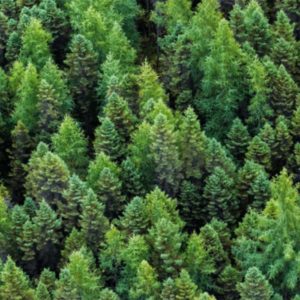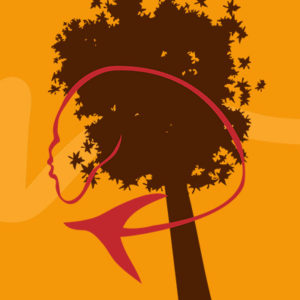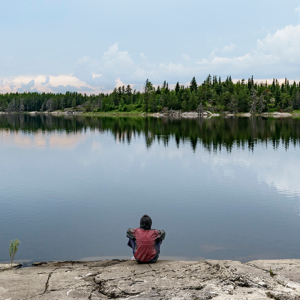Breathing Together: Reflections on Addressing Anti-Racism and Advancing Equity in a Nature Organization
George Floyd’s searing call one year ago—“I can’t breathe”—as a white police officer murdered him in Minneapolis, is forever etched in our minds. That same day Christian Cooper, out enjoying the beauty of birds in Central Park, was threatened by a white woman with police action, and by implication possibly deadly violence—a racist attack on his right to enjoy nature and fresh air. There was nothing unique about that day or those locations. That same day, that same year, through the decades and centuries, racist violence against Black, Indigenous and other peoples of colour reverberate around the world and across Canada.
But over this past year, we have also witnessed in Canada a widening movement and realization of the urgent need for racial justice—from Black Lives Matter demonstrations across the country, persistent Indigenous resistance and activism for Indigenous rights, growing awareness of the pervasiveness of anti-Asian hate exacerbated by this wretched pandemic, and emerging campaigns for a national strategy to combat environmental racism. More organizations and individuals are asking themselves what their own complicity and obligations are to address systemic racism, and how we build a better future for people and the planet.
Nature Canada, where I work, is certainly in a very different place one year later. I am the Policy and Campaigns Director at this 80-year old conservation and nature organization, but I’m also the management lead for our organizational work on anti-racism and equity, which is just getting underway. While I’ve played a key role in getting a workplan on these issues developed and off the ground, equity and anti-racism work is very much also being led by and with others—the workplan is collective; everyone has a role. As the only racialized person on the management team, my vantage is particular.
What follows are some of my personal reflections on our journey over the past year: the road we’ve travelled, what gives me hope, what challenges me, and a look at the path ahead.
Our commitment and why it’s needed in the conservation sphere
Nature Canada is committed to anti-racism and equity. This statement adopted by our Board in early 2021 is one of the more recent outcomes of a conversation begun some years ago, and before I came to the organization, on how to do better. Senior leadership and the Board have made diversity, racial justice and Indigenous reconciliation a priority. Critically, we have confirmed a shared view that pursuing anti-racism and equity is both an ethical imperative and central to our mission. The commitment is intersectional; our work will address racial justice alongside gender, class and other forms of inequality.
It’s important we take this on in the nature community because the history of conservation is a history (and continued reality) of exclusion and displacement. This starts with the historic dispossession of Indigenous peoples from their territories and cultures as part of the creation of parks. But discrimination towards racialized peoples has been a core feature of land use planning across Canada more broadly. Black, Indigenous and other peoples of colour are exposed disproportionately to environmental pollution, toxic waste, climate change, and violence, and denied equitable access to healthy and safe land, water, and protected natural areas. Nature Canada’s research shows that Christian Cooper‘s experience is echoed in Canada, where urban green space is far too often seen as only white space.
Early Beginnings to Now
Nature Canada’s efforts to address anti-racism picked up with earnest in late 2019. Supported by a peer learning process with other grantees of the Hewlett Foundation, we articulated an approach to this imperative and developed early work plan priorities, including getting an assessment of our work on Indigenous reconciliation and re-orienting NatureHood, our program that connects youth and families to nearby nature.
But in March 2020, the organization and all of its plans, along with the rest of the world, were sideswiped by the COVID-19 pandemic, and managing its myriad effects on staff and systems.
In May and June of that year, in the after math of the murder of George Floyd, the aggression on Black birder Christian Cooper—which reverberated through the naturalist community with its own power—and the waves of Black Lives Matter demonstrations that spread across Canada, the Nature Canada team was seized with a kind of uncertainty. We knew what we felt, but were not well prepared collectively to reflect it.
How to act on and articulate our commitment to racial justice with so little developed in practice? The concern about performative action was high, and our internal process undeveloped and strained by remote working. As an organization we opted to amplify the important voices of other organizations and highlight the leadership of Black Lives Matters, as an expression of support without articulating our own beliefs. As individuals, many of us attended rallies, yelling through our masks, channeling with so many others, our collective grief, frustration, and resolve for action.
Since then, and throughout the intense pressures of this year of the pandemic, the Nature Canada team has worked steadily to clarify what we mean by our commitment to anti-racism and equity—and importantly, to develop more systematically what we are going to do about it. It is still early days, and we are very much a work in progress, but Nature Canada has now committed to a whole of organization transformation, along four key tracks:
- Governance: diversifying Board representation and boosting capacity for anti-racism oversight and practice.
- Staffing and Internal Policies: recruitment, retention, and policies and processes for conflict resolution, team building, staff development and more.
- Programs and partnerships: every program–from admin to fundraising. to campaigns and communications—is asked to articulate and develop how their work will advance anti-racism and equity. All of these inform a global anti-racism and equity work plan.
- Culture: how to build a truly welcoming, inclusive, respectful workplace for all, that values and supports racialized and other equity-seeking staff?
We’ve committed to share the lessons of our journey with our supporters and the environmental sector more broadly. Many other organizations are also tackling these issues, or looking to do so, and we are keen to learn with and from others.
Some reflections – Encouragement, Exasperation, Hope
Some parts move faster than others; none of it moves fast enough
It’s perhaps obvious to say, but a key reflection has been the reality that some parts of the work will move faster than others, and it’s been helpful to let those take off. With support from senior leadership, the funders, and skilled and motivated staff, a program area can transform its outlook and partnerships quickly, creating early lessons and inspirations for other aspects of the work, and organizations outside your own. We have seen this with the transformation of NatureHood,, which is now actively working with an anti-racist lens and reaching new partners and communities.
Program development often also happens at the pace of partnership, and that is just as true for the anti-racism work. Progress can feel slow while juggling the realities of protracted negotiations with funding agencies or the timelines and availability of valuable external consultants, many of whom are coping with the burden of racism and the challenges of communities they are serving. As a kind of good but ironic example, the take up and interest of so many organizations in anti-racism training this past year meant agencies offering these were flooded in the summer and fall, unable to cope with demand in the short term!
Building a practice takes practice
We’ve said to ourselves that the commitment to anti-racism, to Indigenous reconciliation and to equity more broadly, isn’t a ‘state’ to achieve but a practice we must continually strive for. It’s a muscle that can only be developed through, well, practice. It means pushing our comfort zones, and juggling the individual with the organizational. We need to do the homework—understand our collective history, our internalized racism and biases, and listen to the perspectives of Black, Indigenous and people of colour. But the fear of practicing anti-racism badly, or making a mistake can also hold us back from doing it at all. I feel this in myself a lot. From outreach to First Nation Inuit and Metis communities, to speaking out against injustice in our external communications, we need to build our practice of antiracism and allyship by doing it. And part of our practice must be humility and learning where we err, and courage to confront racist blowback where it rises.
Hiring is key; retention will be harder
Acting for anti-racism and Indigenous rights as part of our work for nature means engaging with the perspectives, priorities and lived experiences of Black, Indigenous and people of colour. This has to start with who we are as a staff team, but it means developing our supporters, followers, and partners with this intention as well. The internal and external are closely linked. Representation in environmental and nature organizations has been flagged as a key barrier and therefore must be a priority for the sector.
We’re making progress at Nature Canada, prioritizing this experience for recruitment across staff positions. A period of rapid growth and some turnover has enabled important diversification of the teams, mainly at the staff level, although no clear goal has been set in this regard. Already we are having different conversations than we had one year ago, and I’ve seen how the skills, experiences and networks of racialized staff have greatly increased the reach and impact of our work. Longer term, our ability to retain and continue to recruit racially diverse staff will be shaped by the progress we make in transforming our organization and its culture.
‘Diversification’ at the management level will be an important goal to tackle ahead to build sustained progress. Personally, I’ve struggled at times with the slower pace and comfort of the senior management team on issues of race and gender. Other times, we move easily together to advance the work. I am learning to be patient, and expect bumps and learning (including my own) along the way, as we make progress.
More broadly, inclusion and representation of racial and gender diversity in the sector must mean openness to these voices shaping what our environmental priorities, strategies and solutions are, not just inclusion for support of the agenda as currently constructed.
Transforming our Work Culture: So hard, so necessary.
Developing an anti-racist, respectful and inclusive work culture, one committed to learning and unlearning so that we can grow together, may be the hardest practice to build. But it is the sine qua non for sustained and meaningful changes across policies, programs, and staffing. We need to create the work environment that will ensure we can reflect, evaluate, scale up and reorient our work as needed in support of racial and environmental justice.
It’s not easy. Learning through training and reflection sessions are critical and need to be ongoing. Nature Canada has an internal cross-team staff committee that generates ideas and creates spaces to support the learning and transformations required. The appetite for this is huge in the staff team—what is unconscious bias and how to recognize and curb it? What are microaggressions? How to deal with encounters with racism with external or partner organizations? How to appreciate and understand different kinds of knowledge systems? Times we have taken for staff training or learning sessions have been invaluable and have helped us get vulnerable and reconnect with each other in a robotic year of remote work.
Beyond the trainings and planned learning sessions, constructing a new culture with each other happens in the every day. All staff, not just racialized and not just white staff, need to take responsibility for the work. How to push through our comfort zones to name what we are experiencing, and encourage folks to do work on their own internal racism and unconscious biases? The work is messy and often means uncomfortable and at times conflictive exchanges. The discomfort and the tension being surfaced more openly is a sign of growth and new societal norms being built regarding what we expect brown and black staff to endure or flag, white staff to acknowledge and understand, and all staff to be responsible for.
Co-creating the future – it’s on all of us
A key focus, from what I see, is to enable organizations and people to learn, change and build forward together. It requires a belief and trust that we can actually do it– that other people can learn and change; that we can look in ourselves confront our internalized racism and sexism, and make needed changes. And we need to allow that individuals pursuing these goals with integrity can also make mistakes and be forgiven, where there is acknowledgment and resolve to do better.
But individuals’ commitment and action will never be sufficient to build an anti-racist work culture. Organizational cultural change must be intentionally cultivated through broader policy and priority setting, supported by leadership and governance structures. This includes mechanisms to ensure accountability where racist practices and other harmful inequalities persist. Ultimately, we need approaches that build resilience, enabling organizations and their staff to adapt and change for the better in ways that generate meaningful outcomes for equity-seeking groups.
I am hopeful for the future of Nature Canada on this journey. I see a staff team committed to address anti-racism in our work and workplace, and yearning to understand better how to do it.
Human beings are united through our dependence on Nature. The planet and its living systems— water, forests, ocean, air—are our shared foundation with all species. My hope is that in thinking of ourselves as part of Nature, we are reminded of our essential connection to each other.
Decades ago, I was moved to tears by a speech from the great scientist and activist David Suzuki, in which he illustrated this profound connection by recounting the proposition of astronomer Harlow Shapley— that every person on Earth, throughout history, from the famous to the ordinary, ultimately and literally, breathes the same air.
Specifically, with each breath in and out we take, we briefly hold within us and then release to others, atoms of inert argon gas that comprise 1% of our atmosphere and circulate permanently among us through all of time. Our very breathing connects us all.
Yet as George Floyd’s death and last words demonstrated so painfully a year ago, profound inequities that are an affront to our shared humanity abound–including in how freely we can breathe the air that is our collective birthright.
We need, together, to breathe life into a new future, co creating a world with rights and dignity for all people, for all of Nature.
Gauri Sreenivasan



